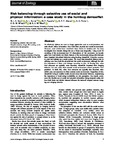Risk balancing through selective use of social and physical information: a case study in the humbug damselfish
| dc.contributor.author | Kent, MIA | |
| dc.contributor.author | Burns, AL | |
| dc.contributor.author | Figueira, WF | |
| dc.contributor.author | Mazue, GPF | |
| dc.contributor.author | Porter, AG | |
| dc.contributor.author | Wilson, Alexander | |
| dc.contributor.author | Ward, AJW | |
| dc.date.accessioned | 2019-06-25T15:34:02Z | |
| dc.date.available | 2019-06-25T15:34:02Z | |
| dc.date.issued | 2019-03-29 | |
| dc.identifier.issn | 0952-8369 | |
| dc.identifier.issn | 1469-7998 | |
| dc.identifier.other | jzo.12669 | |
| dc.identifier.uri | http://hdl.handle.net/10026.1/14452 | |
| dc.description.abstract |
<jats:title>Abstract</jats:title><jats:p>To effectively balance the need to forage against the need to avoid predation, animals should utilize information from both their physical and social environments. However, most studies have considered these factors in isolation and few have investigated how animals change the use of these cues temporally. Using novel 3D modeling of the environment and 3D observations of fish movement, we investigated how local abiotic and biotic features of the environment, along with tidal patterns, impacted risk‐related behaviors using humbug damselfish, <jats:italic>Dascyllus aruanus,</jats:italic> in coral reef habitats as a model system. We found that damselfish balance risk by utilizing cues from both the physical and the social environment, although the relative importance of these cues changes according to tide. At flowing tide, when food resources are typically more abundant, damselfish increased their foraging behavior, but only when their external social environment offered protection from predation. At slack tide, when food resources are typically less abundant, damselfish were not responsive to their external social environment. Regardless of tide, damselfish living in smaller corals showed more risk‐averse behavior, emphasizing the importance of local refuge availability on risk perception. Our results underscore the flexible use of social and physical information along temporal scales and how both biotic and abiotic features influence the trade‐off adopted between foraging and refuging behavior.</jats:p> | |
| dc.format.extent | 235-242 | |
| dc.language | en | |
| dc.language.iso | en | |
| dc.publisher | Wiley | |
| dc.subject | risk balancing | |
| dc.subject | predation risk | |
| dc.subject | coral reef | |
| dc.subject | Dascyllus aruanus | |
| dc.subject | refuge | |
| dc.subject | 3D modeling | |
| dc.subject | social environment | |
| dc.subject | risk perception | |
| dc.title | Risk balancing through selective use of social and physical information: a case study in the humbug damselfish | |
| dc.type | journal-article | |
| dc.type | Journal Article | |
| plymouth.author-url | https://www.webofscience.com/api/gateway?GWVersion=2&SrcApp=PARTNER_APP&SrcAuth=LinksAMR&KeyUT=WOS:000477897300001&DestLinkType=FullRecord&DestApp=ALL_WOS&UsrCustomerID=11bb513d99f797142bcfeffcc58ea008 | |
| plymouth.issue | 4 | |
| plymouth.volume | 308 | |
| plymouth.publication-status | Published | |
| plymouth.journal | Journal of Zoology | |
| dc.identifier.doi | 10.1111/jzo.12669 | |
| plymouth.organisational-group | /Plymouth | |
| plymouth.organisational-group | /Plymouth/Faculty of Science and Engineering | |
| plymouth.organisational-group | /Plymouth/Faculty of Science and Engineering/School of Biological and Marine Sciences | |
| plymouth.organisational-group | /Plymouth/REF 2021 Researchers by UoA | |
| plymouth.organisational-group | /Plymouth/REF 2021 Researchers by UoA/UoA07 Earth Systems and Environmental Sciences | |
| plymouth.organisational-group | /Plymouth/Users by role | |
| plymouth.organisational-group | /Plymouth/Users by role/Academics | |
| dcterms.dateAccepted | 2019-03-05 | |
| dc.rights.embargodate | 2020-3-28 | |
| dc.identifier.eissn | 1469-7998 | |
| dc.rights.embargoperiod | Not known | |
| rioxxterms.versionofrecord | 10.1111/jzo.12669 | |
| rioxxterms.licenseref.uri | http://www.rioxx.net/licenses/all-rights-reserved | |
| rioxxterms.licenseref.startdate | 2019-03-29 | |
| rioxxterms.type | Journal Article/Review |


